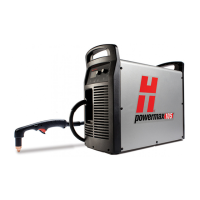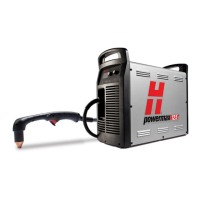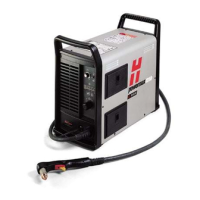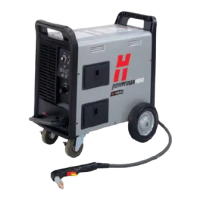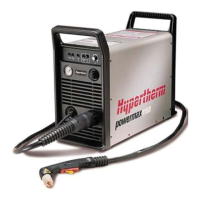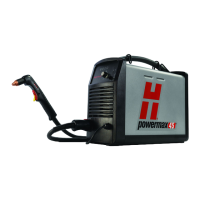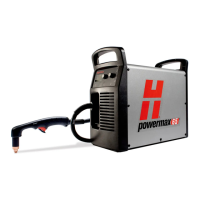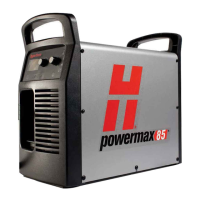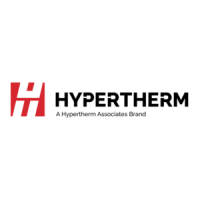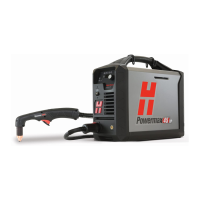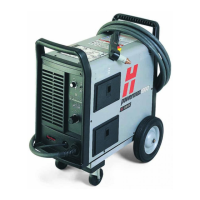MAINTENANCE
1
powermax1000 Service Manual 3-15
Problem This may mean Cause Solution
Consumables not installed, installed
improperly, or damaged.
Refer to the consumables diagram in Section 5 or to the Operator
Manual for proper installation. Try new consumables and turn off the
power and then turn it on again to clear the error.
Damage to cap sensing circuit. Perform Test 9.
Exceeded duty cycle. Allow unit to cool. Work within duty cycle limits in manual.
Fan not operating or operating
improperly.
Defective heatsink temperature switch
(TP1) Check when system is cool, at
least 15 min after use.
Remove connector J2 from power board (PCB2). Check the
temperature PCB (PCB4) by checking the resistance on pins 1 and 2.
If the resistance is greater than 300 ohms on the heatsink and 458
ohms on the transformer, replace the control board (PCB3). If the
resistance is lower than stated, replace the temperature sensor PCB
(PCB4).
Defective power transformer (T2) or
temperature sensor (TS2). Check
these when system is cool, at least 60
min after use.
Check the transformer sensor (T2) by checking the resistance on J21
pins 1 and 2. If the resistance is greater than 300 ohms on the
heatsink and 458 ohms on the transformer, replace the control board
(PCB3). If the resistance is lower than stated, replace the
temperature sensor PCB (PCB4).
Damaged torch or lead
assembly.
Torch plunger stuck open or broken
torch leads.
Verify the TSO (Torch Stuck Open) LED illuminates (see
Control
Board LEDs
). Perform Test 7.
Pilot Arc IGBT (Q8) not working.
Faulty pilot arc IGBT (Q8), power board
(PCB2), or control board (PCB3).
No output from power board
(PCB2).
Faulty inverter IGBT (Q6) or power
board (PCB2).
No air flow when trying to fire the
torch and no fault LEDs are
illuminated. Air flows when in test.
Start signal not being received
by power supply. Start LED OFF
on control board (PCB3). See
Control Board LEDs
.
Damage to torch or lead assembly for
manual torch. Damage to interface
cable or no input from CNC for
mechanized applications.
Manual torch: check the start wires; see wiring diagram. Mechanized
torch, perform Test 8.
No air flow when trying to fire the
torch, no fault LEDs are illuminated,
and no air flows when in test.
Solenoid valve not working. Valve stuck or no voltage to valve. Perform Test 10.
Worn or damaged consumables.
Overused or improperly installed
consumables.
Insufficient air flow. Improper pressure setting.
Turn current adjustment knob to test flow and set pressure regulator
70 psi (4.7 bar) for cutting and 50 psi (3.4 bar) for gouging.
Damaged torch or lead
assembly.
Electrode is not moving properly in the
torch, or there is a short-circuit in the
torch leads.
Faulty power board (PCB2).
Voltage imbalance across bus
capacitors.
Perform Test 2 while trying to fire the torch. If voltage across
capacitors is not balanced, then replace the power board (PCB2).
No air flow when trying to fire the
torch. Fault, Pressure, and AC LEDs
are illuminated.
Cap sensing circuit not satisfied.
Yellow cap-sensing LED illuminates.
Over temp LED illuminates.
Temperature sensors indicating
an over temperature condition.
When pressing the torch trigger or
start switch, air flows from the torch,
but the torch does not fire or fires
for only a short duration.
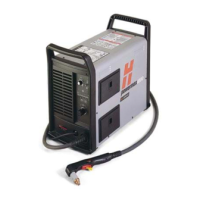
